My first few blog posts of the new year will focus on the high-tech tools that might assist in keeping some classic New Year's resolutions. Today we'll look at the technology behind e-cigs, vapes and other vapor-based smoking cessation solutions!
Also, some of the things I'll talk about here are dangerous. Please don't use e-cigarettes if you're under the age of 18 and even then, we don't recommend using nicotine at all. All experiments here were performed with non-nicotine vape juice.
It's a tale as old as time: "This year is the year I quit smoking."
According to Statistic Brain, it's the fourth most common New Year's resolution, and with good reason! I'll spare you the grisly statistics (of which we are all aware), but smoking is really bad news. Because of the addictive quality of nicotine (and, by extension, tobacco) it can be a formidable challenge to stop smoking. Many products have been designed and marketed to improve the success rate. Nicotine patches and gum attack the neurochemical cause of addiction by helping smokers slowly reduce the amount of nicotine they're exposed to. Nicotine inhalers deliver nicotine and reduce exposure to the combustion products of smoking, but also help to satisfy the physical habit. These traditional smoking cessation products have worked to varying degrees for different people, but by far the most common today appears to be e-cigarettes.
The use of e-cigarettes, or "vaping," has enjoyed a meteoric (if controversial) rise in popularity, both as a smoking cessation practice and as a hobby. By some reports, the industry has grown from $20 million in 2008 to over $2.5 billion in 2015. The science on whether or not vaping is a healthy habit is still being done, but it seems likely that it's considerably less harmful than smoking --- thus the appeal. Besides being a potentially less harmful alternative to smoking, it's also the kind of hobby that appeals to techies and gear nerds. It may seem like an e-cig is an e-cig, so what's to geek out about, right? Well, it turns out there's more going on here than you might expect. I took the company credit card to the local smokeshop/vapeshop/what-even-is-that-shop to see what I could learn...
The Basics of Vaping
There are a wide range of devices that people use to "vape," but they all work in basically the same way. A piece of wire is wrapped around a wicking material soaked in the vaping solution. A current is applied to the wire, and it heats up, boiling the solution off into a fine vapor. The solution (sometimes called "e-liquid" or "juice") is composed largely of propylene glycol and/or vegetable glycerin. These are the same ingredients used in some theatrical fog/smoke machines, because the vapors that they produce are thick and persistent. The glycerol base is flavored with food-grade flavoring agents, and nicotine is added to varying levels depending on the user's preference.
A fairly standard vape tank with bottom airflow and a "510" power connector
Generally speaking, the term "e-cig" refers to a device that looks like a traditional cigarette. The coil and wick (collectively known as the atomizer) in this type of device are usually built into a replaceable cartridge, which is sometimes pre-soaked with juice. Devices that are referred to as "vapes" generally use a tank system. The tank is a refillable container of juice into which the wick is submerged. This allows the user to vape longer without having to buy new cartridges; they simply need to refill the tank. The coils will eventually wear out, though, and many of these systems allow for quick replacement of pre-built coils. Finally, "mods" are devices that bear almost no resemblance to traditional cigarettes or pipes whatsoever. These are the devices we'll experiment with today because they're often the most electrically interesting...
Mods
Mod boxes come in various shapes, sizes and types, but they basically break down into two camps: regulated mods and unregulated (or "mechanical") mods. Regulated mods are essentially pocket-sized, variable-voltage power supplies. They're designed to drive very low-resistance heating elements so they can dump several amps from the internal battery. Regulated supplies allow the user to control the amount of power being applied to the coil (usually in the range of 5--100W, but sometimes higher) and limit the draw from the battery. Many regulated supplies even offer battery cell protection against over/undervoltage and fast discharge. Mechanical mods, on the other hand, are essentially a battery on a switch. An unprotected lithium cell is placed in series with a momentary switch and a heating coil, and sometimes a fuse is added for (minimal) protection. These are usually the rigs that you see on the news exploding in people's hands, because they allow the user to over-tax the battery to a dangerous degree, and when lithium batteries fail, they do so spectacularly.
So why do people build dangerous mods? Well, sometimes it's because building a regulated mod is harder to do, and sometimes it's just because building a regulated supply for the power levels they want would be expensive and impractical. Either way, it's usually in service to the craft of "cloud-chasing," or blowing the biggest, thickest cloud of vapor that you can. It takes a lot of power to flash-boil glycerol! Whereas normal vaping takes between 5 and 15W of power, cloud-chasers will build mods capable of dumping 250W or more across the coil. As you can imagine, this is bad for all sorts of reasons, including:
- Overheating glycols can degrade them into aldehydes (such as formaldehyde), which are toxic.
- Overdrawing from the lithium batteries can cause them to explode.
- Rapidly heating and cooling a coil to that extent may even cause nano-particles of the constituent metal to enter the vapor stream.
There are all kinds of reasons not to push the limits on vaping, but those people exist in any hobby, I suppose.
Ohm's Law and #VapeLyfe
As it turns out, the vaping community has an intimate connection with Ohm's law. Because they're concerned with dropping a lot of power across a fixed resistance, Ohm's law is basically the vaper's bible. For example, one of the mods I procured has an OLED screen that displays the current power setting, the resistance of the coil and the voltage applied during use. With a 1.84Ω coil installed and the power set to 15W, the displayed voltage is 5.25V. If you just did the math in your head, you should have noticed the following:
15W ≈ 5.25V x (5.25V/1.84Ω)
Which means that my mod is applying about 2.8A of current across the coil. Once you understand this relationship --- and the fact that batteries have safe and unsafe discharge rates --- you start to see the importance of choosing your batteries and coils carefully. For instance, let's examine the other tank that I picked up:
Look at all the machined steel and glass you get for $50! Way to go, China!
This tank comes with a few different pre-built coils, so I picked one at random and decided to test it on the multimeter. The coil assembly had the following etched into the side:
0.15Ω 30-70W BEST 45-60W
This is a Sub-Ohm coil! These coils are usually used by cloud-chasers and advanced vapers because they can dump a lot more power from a fixed-voltage device, like a mechanical mod. Let's check that resistance value:
This could be easier.
After nulling out the resistance of the leads, this meter is reading 0.19Ω, which I expect is due to the resistance of the steel cartridge body and difficulty of getting a good connection against the threads. A measurement of the higher-resistance coil from the other rig corroborates what the mod itself measured (1.84Ω).
So why does having a lower resistance coil allow you to dissipate more power in a fixed voltage system? It's Ohm's Law again! Let's do the math: Assume we have a mechanical rig consisting solely of an 18650 lithium cell and a momentary switch. A single lithium cell is capable of making about 3.7 volts, so if we attach that battery to our 1.84Ω coil, we can pump 3.7V x (3.7V/1.84Ω) ≈ 7.4 Watts of power through it. On the other hand, if we connect the 0.2Ω coil: 3.7V x (3.7V/0.2Ω) ≈ 68.5 Watts!! That's a big boost, so what's the catch?
Well, you should have noticed that the current values in these two equations (while not shown) are radically different. A lower resistance coil allows a lot more current to flow. In the first scenario, our lithium cell was only sourcing 2A, but in the second scenario that number jumps to 18.5A! If you actually wanted to build this mod, Ohm's Law might save your life because now you know what the discharge rating of your battery should be. Assuming our 18650 battery has a capacity of 2600mAh, it might slide by on a discharge rate of 1C while powering the 1.84Ω coil. The same battery would need to have a discharge rate of at least 8C (you probably want it rated to at least 10C).
Playing with Coils
It takes so much current to heat up a low-resistance coil that I had trouble digging up a bench supply to do it. Eventually, I ended up connecting a 350W MeanWell power supply and was able to make vapor. The supply maxes out at about 14A, so it was not happy. Doing the math, it was only able to push about 2V down the line and was hitting its current limit.
CLOUDS, BRO.
So what if your rig requires a very particular resistance in order to operate? Well, you always have the option of building your own coil. The tank shown above even came with a rebuildable atomizer for people who want to wind their own coils. Coils are wound from several different materials, including Kanthal, nickel, Nichrome, titanium and 316L stainless steel. These different types of wire are wound into intricate shapes and then mounted into rebuildable atomizers to achieve specific properties and performance.
So What Did We Learn?
Well this has been a lot of fun, but did we really learn anything in all this? Sure, we did! We learned:
- Ohm's Law is very important
- Batteries have maximum discharge rates
- Regulated mods are basically pocket-sized variable voltage supplies
...which gives me an idea... check out my new mod...
#VapeLyfe
If you found this article interesting, leave me a comment, and maybe I can write more about this in the future. I know there's a huge custom mod community out there, and there's a lot more technology to cover. For instance, I found out that a popular regulated mod board on the market now is based on a 32-bit microcontroller! Also, I didn't even have time to cover DC-DC boost circuits in this post. There's a lot to geek out about here.











I can't help but think of the smoke, and the 8bit 'chug', of my childhood electric train. I remember my efforts to get more smoke out of the engine. A friend built this battery powered fog machine for a project he's been working on and I've seen smoke generators used in wearables. I'm ready for the next article on this.
VapeNation
Interesting article thanks. Just a minor thing, some people struggle with the concept of current flowing through a coil and potential (voltage) being across a coil, so it's best to avoid saying "...current across the coil..." Cheers,
Thanks for this! I was left with one more question though. Maybe this is obvious: more power should mean more vapor. But, if it's heat that makes vapor, and if it's hard to heat up a low-resistance coil, it's not obvious (to me) why you'd want more power and lower resistance. I assume what a vaper really wants is maximum heat in the atomizer(?). If so, is it the case that sub-ohm coils have much more surface area (more windings etc.) than higher-ohm coils, so that they can release more heat or something like that? Seems like heat and surface area are the key parameters here: you want as much heat x area as possible in the coil, and you DON'T want your battery heating up. Is that the right way to look at it? Or rather, you want to reach a fixed maximum heat level in the atomizer (so you don't produce formaldehyde), but you want it distributed over the largest surface area for the biggest cloud. Is that right?
What a great article. I have been toying with the idea of creating a smoke machine for an electric rc plane using vape mods. I am not certain about the volume of smoke that could be produced, but the Lipo batteries can handle the current. I knew nothing about mods other than the billowing clouds some students produce in the washroom of the school I work. This article has the DIY juices flowing. Feel free to run another article on making smoke or fog, nudge nudge...
Hi Nick, Im very happy you finally want to quit smoking through vaping! Believe it or not, vaping is way much better than traditional cigarrete. Im vaping now for more than a year and half, feel REALLY much better and there is no way at all I come back. Your'e right, there is a lot of interesting technology in the electronic mods with high-current buck converters, charging circuitry etc All that pretty interesting if you feel that you want to dig into. It's a pretty DY world and even myself I made last year an automatic e-juice CNC made mixing device with and Arduino with a few parts from Sparkfun (not really serious project, but fun to make!). You can check it out here on youtube if you want to see it ;) Anyway, keep vaping and enjoy it as much as you can, there are tons of favours. Do not worry about the sensationalism about exploding batteries because some people don't know about Ohm's Law ;)
You might want to run some power loss calculations on the (undersized) test leads you used to connect the coil to power. ;-)
Oh I did, actually.*
*I held the leads in my hand and when they got warm I added another in parallel.
EDIT: I confused series and parallel because I do electronics good.
If you measure the resistance of your test leads, I think you'll find them equal or greater than the vape coil. If that's the case, 2/3 or more (!) of your power is being used to heat the leads and not the coil. In other words, your coil can be 3-4 times more powerful just by using different wires to hook it up! It's easy to think of Ohm's Law as applying only to particular parts in a design, but a circuit is always a continuous loop. Every part of the loop has some V=IR description that you can model, and they all add up to match the whole.
As I read this my only question is does the momentary switch ever fail? Seems like a lot of current going into an inductive load is going to create arcing as the contacts separate. Welded contacts would not be a good thing!
Very interesting article. Vape is something I am against, but facts are always good. I was wondering how all this works. I think building a miniature smoke machine has got my interest and doing it within the safe discharge levels has also my interest. I was thinking a big capacitor discharge might also be a variation. Charge the cap safely and then discharge the cap to avoid battery surprises.
Only Sparkfun allows an employee to take the company credit card to a vape shop!!! LOL!!!
Does anyone else find this a bizarre subject to have on the front page of SparkFun? With your emphasis on education, I was surprised to see you featuring this content. Is this the dawn of an edgier SparkFun?
We don't always succeed but there is a conscious effort not to lose our wider appeal as we enter the education market. SparkFun would like to think that we have a history of "edgy" content, not for the purpose of being contrary or controversial but simply because we understand that people have a wide range of interests within the "maker" community and everything isn't for everybody.
Hopefully as we grow into the education community, we don't lose sight of our "edgier" beginnings and we'll find a way to separate our education content from our general maker content when it's appropriate.
Hope you enjoy seeing a wide variety of hobbies and interests on the front page, that's kind of my core motivation as a Creative Tech at SparkFun. Thanks for taking the time to read!
I have a deep respect for how open SF is as a company and I appreciate your response. I don't want to see you guys narrow your focus to any specific topic, it was just jarring to go from a huggable plush project one day to vaping the next. I probably should have said 'unusual' in my original comment as opposed to 'bizarre'- my bad on that.
here here!
Sources of fog are nice for cosplay, too. Some cosplayers would like to produce huge clouds of billowing fog from a tiny device, and the popularity of vaping and ingenuity of the Chinese have made the hardware much more varied, affordable, and accessible. I have no interest in vaping, but much interest in miniature fog machines and power engineering. At the end of the article, where it refers to DC-DC boost supplies, I immediately thought "point of load buck (not boost) supplies would be the way to go for this sort of low voltage, high current duty."
No nicotine? Be ready for at least a year of feeling like you lost 20 or 30 IQ points. Nicotine is tremendous for concentration. Look at engineering. The SR-71 was designed using chain smoking. Now we need high performance computers running simulations and CAD. Grad schools and tech design and the space program used to run on tobacco.
When was the last great physics breakthrough? They will have to come from places that still allow smoking in the workplace and classrooms! Oh well. Maybe chewing coca leaf will become legal.
Is there any chance you can site your source on this? I'd love to add it to a class I teach on unintended consequences. Here's one to add to your dinner time conversation. Why is the smoking ban causing an increase in the mortality of baby sparrows? Think about it before you click the link.
There are many studies that confirm this. Here is a brief synopsis http://www.webmd.com/smoking-cessation/news/20021023/harnessing-nicotines-power
I smoked my way through math and physics. We took ash trays to class and professors smoked in class. I recall David Berlinsky taught Philosophy of Science in a very small room and put out his smokes in the chalk tray. Graduate level problems could take weeks and I don't think very many people could use Newton's method of keeping the problem "constantly before the mind" without the nicotine, though there were certainly non-smokers who out-shined us less promising types.
If I was back in school I would seriously consider vaping or patches.
Thank you!
Awesome! There is a lot of noise about e-cigs, specially about the exploding ones. They say to just not vape because the devices explode, but they don't say anything about mech-mods, lithium batteries, sub-ohm coils, current limits, short circuits, insulation and all the stuff that can make the battery explode.
Nice overview! I spent much of a day researching these, mostly the interesting high temperature alloys used in the coils, last time I was stuck in bed sick. This hit all of the points that stuck in my head from my research.